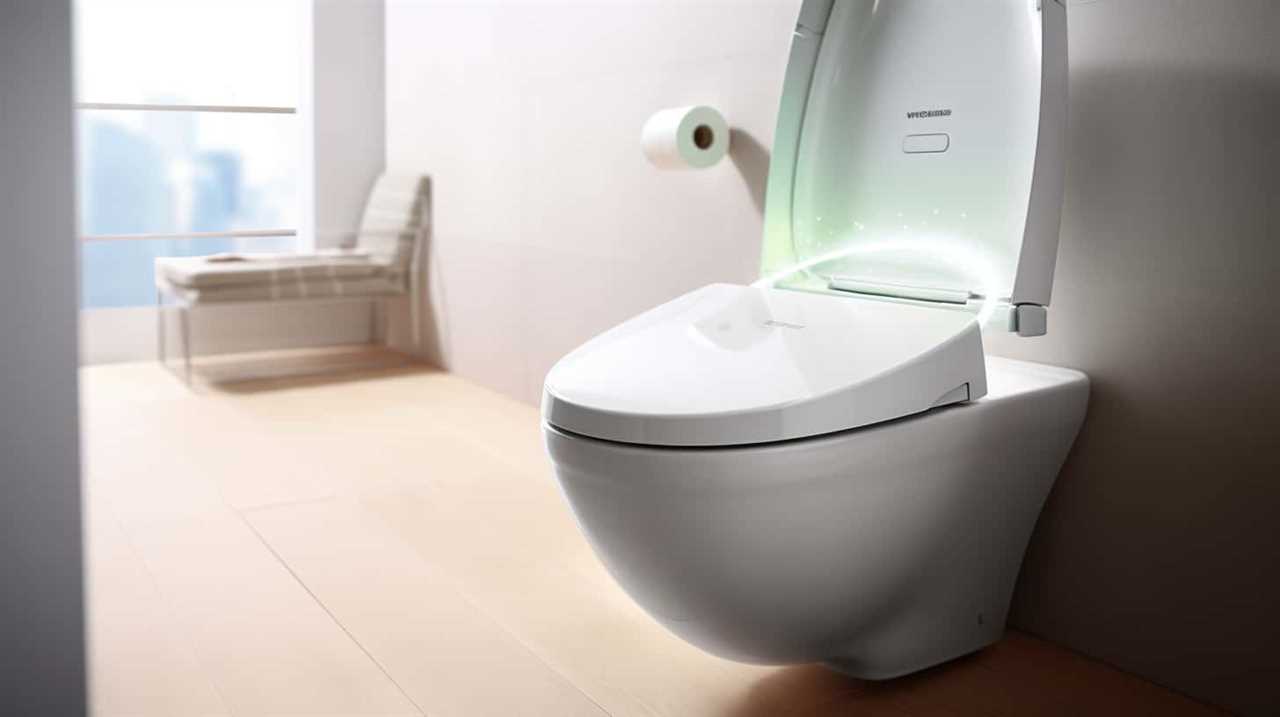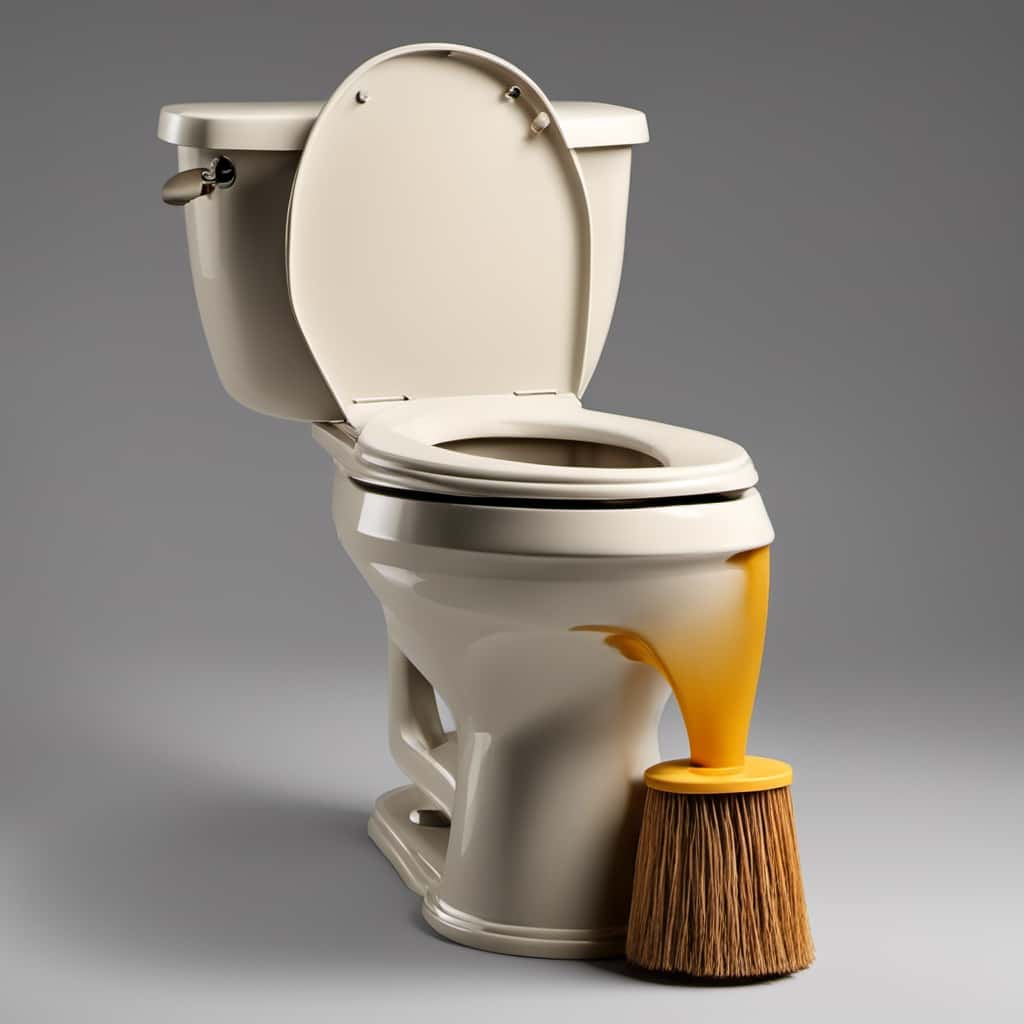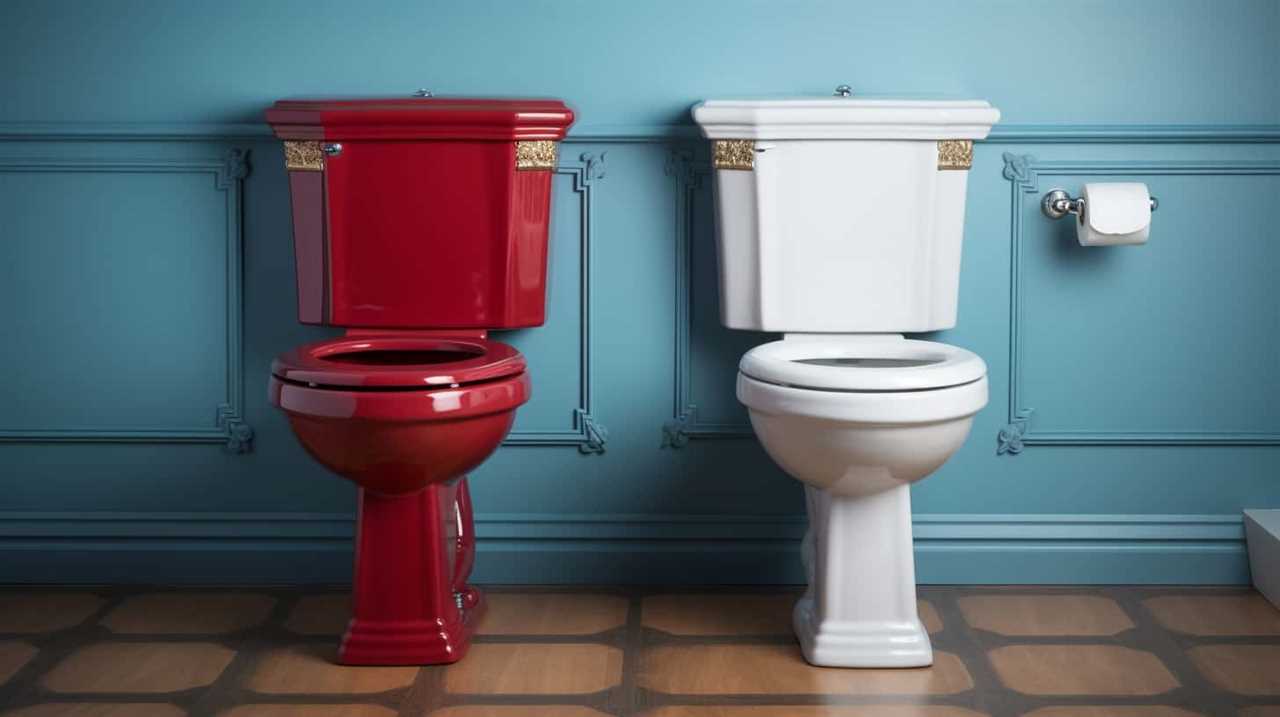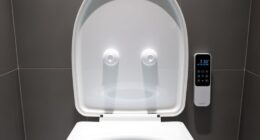Ever curious about the functioning of a hidden cistern?
Let us take you on a journey to uncover the inner workings of this ingenious device.
With its precision-engineered components and efficient water supply, the concealed flush tank ensures a powerful flush with minimal noise.
From the flapper valve to the dual flush system, we will explore every aspect, shedding light on its silent operation and providing expert tips for maintenance and troubleshooting.
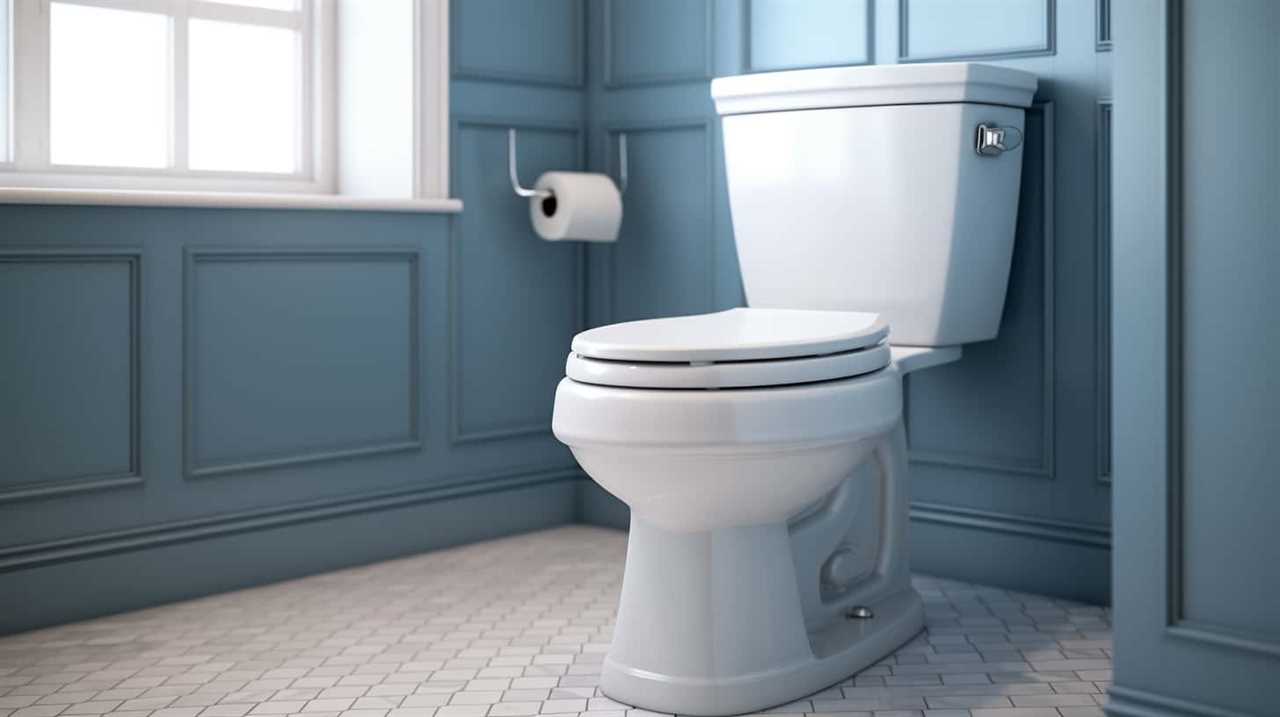
Get ready to master the art of understanding concealed flush tanks.
Key Takeaways
- Components of a concealed flush tank include a flush valve, fill valve, overflow tube, cistern, and lever.
- Water supply in a concealed flush tank can be regulated through water-saving mechanisms, dual-flush systems, pressure-assisted flushing, adjustable water levels, and efficient refill mechanisms.
- The flushing mechanism of a concealed flush tank incorporates water-saving technology, effective waste removal, flushing efficiency, and reliable and efficient flushing.
- The flapper valve in a concealed flush tank regulates water flow, lifts during flushing, closes to ensure efficient water usage, requires regular inspection, and proper chain length adjustment for sealing and prevention of water leakage.
Basic Components
We will now discuss the basic components of a concealed flush tank.
A concealed flush tank is an essential part of a modern water-saving toilet system. It consists of several key elements, including the flush valve, the fill valve, and the overflow tube.
The flush valve is responsible for releasing a large amount of water into the toilet bowl, enabling an efficient flush. It’s designed to ensure water conservation by allowing for a quick and thorough flush while using minimal water.
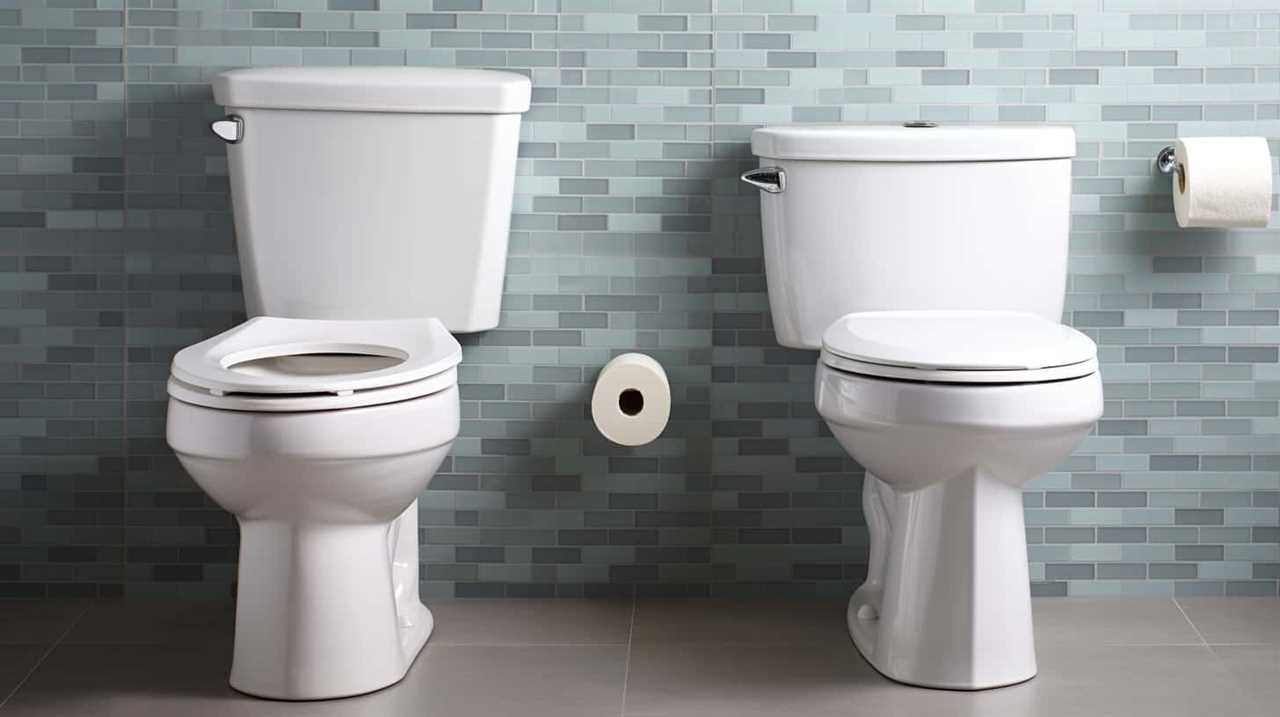
The fill valve, on the other hand, is responsible for refilling the tank after each flush. It controls the flow of water into the tank, ensuring it reaches the desired level for the next flush.
Lastly, the overflow tube prevents the tank from overflowing by diverting excess water into the bowl.
Understanding these basic components is crucial for maintenance troubleshooting and ensuring optimal performance of a concealed flush tank.
Water Supply
The water supply is a vital component of a concealed flush tank, ensuring a consistent flow of water for each flush. To achieve water efficiency and conservation, the water supply in a concealed flush tank operates in the following manner:

- Water-saving mechanism: The concealed flush tank is equipped with a water-saving mechanism that controls the amount of water used for each flush, reducing wastage.
- Dual-flush system: Many concealed flush tanks are designed with a dual-flush system, offering users the option to choose between a full flush or a half flush, depending on the type of waste.
- Pressure-assisted flushing: Some concealed flush tanks utilize pressure-assisted flushing, which uses air pressure to force water into the bowl, resulting in a more powerful flush while using less water.
- Adjustable water levels: The water supply in a concealed flush tank allows for adjusting the water level in the tank, ensuring optimal performance and water efficiency.
- Efficient refill mechanism: The water supply system in a concealed flush tank incorporates an efficient refill mechanism, quickly replenishing the water in the tank after each flush, minimizing downtime and ensuring continuous operation.
Flushing Mechanism
As we continue exploring the workings of a concealed flush tank, let’s delve into the flushing mechanism.
The flushing mechanism in a concealed flush tank is responsible for effectively and efficiently removing waste from the toilet bowl. It ensures that the right amount of water is released with enough force to create a powerful flush, while also conserving water.
Flushing efficiency is achieved through the use of water saving technology, such as dual flush systems or pressure-assisted flushing. Dual flush systems allow users to choose between a partial flush for liquid waste and a full flush for solid waste, reducing water consumption.
Pressure-assisted flushing uses compressed air to generate a forceful flush, requiring less water while still maintaining flushing effectiveness. These mechanisms work together to provide a reliable, efficient, and water-saving flushing solution.

Flapper Valve
The flapper valve is a crucial component of the concealed flush tank mechanism. It’s responsible for regulating the flow of water during the flushing process.
When the flush lever is pressed, the flapper valve lifts, allowing water to rush into the toilet bowl and initiate the flushing action.
As the water level in the tank decreases, the flapper valve closes, preventing further water flow and ensuring efficient water usage.
Flapper Valve Mechanism
One important component of the concealed flush tank is the flapper valve mechanism. The flapper valve is responsible for controlling the flow of water from the tank into the toilet bowl during a flush. It’s a crucial part of the flushing process and requires proper maintenance to ensure optimal functionality.

Here are some key points to consider regarding flapper valve maintenance and troubleshooting:
- Regularly inspect the flapper valve for any signs of wear or damage.
- Clean the flapper valve and the surrounding area to remove any buildup of debris or mineral deposits.
- Adjust the chain length to ensure proper sealing and prevent water leakage.
- Replace the flapper valve if it’s worn out or not sealing properly.
- Check the water level in the tank to ensure it isn’t too high or too low, as this can affect the performance of the flapper valve.
Water Flow Regulation
To regulate the water flow in a concealed flush tank, we use a flapper valve mechanism. This mechanism plays a crucial role in achieving water conservation and efficiency.
The flapper valve is a rubber or plastic component that seals the flush tank’s drain opening when not in use. When the flush handle is pressed, it lifts the flapper valve, allowing water to rush into the toilet bowl.
The duration for which the valve remains open determines the amount of water used for each flush. To enhance water conservation and efficiency, modern flapper valves are designed to minimize the flow rate during flushing. These valves are engineered to ensure a sufficient amount of water is released to effectively clean the bowl while using the least amount of water possible.

Dual Flush System
For our discussion on the dual flush system, let’s delve into how it works.
The dual flush system is an innovative water-saving technology that offers several benefits. Here’s how it operates:
- Two flush buttons: The dual flush system features two buttons on the toilet, one for a partial flush and the other for a full flush.
- Partial flush: The partial flush button is designed for liquid waste and uses less water than a traditional flush, conserving water and reducing water bills.
- Full flush: The full flush button is used for solid waste and provides a more powerful flush, ensuring effective waste removal.
- Water efficiency: By offering two flush options, the dual flush system allows users to choose the appropriate flush for different waste types, resulting in significant water savings.
- Environmental impact: The dual flush system helps in conserving water resources and reducing the strain on wastewater treatment plants, contributing to a more sustainable environment.
Flush Actuator
Operating with a hidden mechanism, the flush actuator triggers the flushing process in concealed flush tanks. The flush actuator is a crucial component that allows users to activate the flush without direct contact with the tank. There are several types of flush actuators available, including push buttons, levers, and touchless sensors. The installation of a flush actuator depends on the specific design of the concealed flush tank. It typically involves mounting the actuator on the wall or embedding it into a countertop. To provide a clear visual representation, here is a table showcasing different flush actuator types and their installation methods:
| Flush Actuator Type | Installation |
|---|---|
| Push Button | Wall-mount |
| Lever | Wall-mount |
| Touchless Sensor | Countertop |
Water Pressure
Now let’s delve into the subtopic of water pressure, which plays a crucial role in the functioning of a concealed flush tank. Understanding water pressure is essential to comprehend how a concealed flush tank operates efficiently.
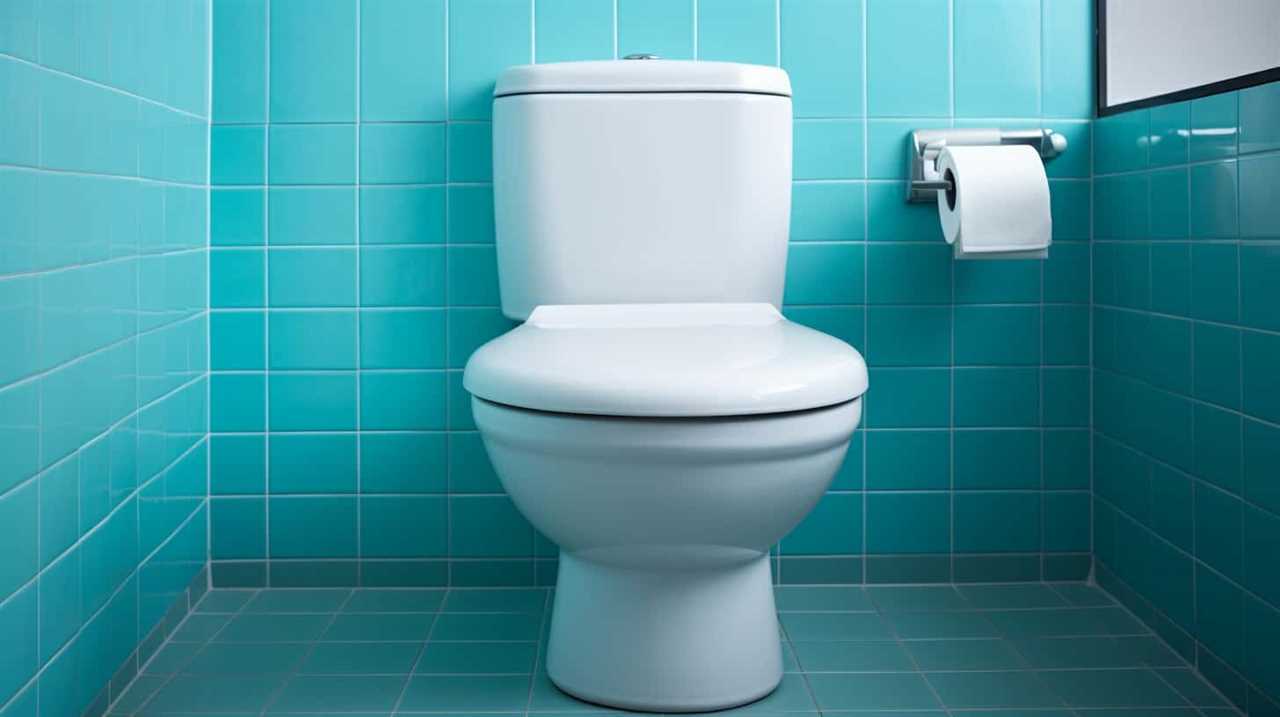
Here are five key points about water pressure in relation to concealed flush tanks:
- Water pressure is responsible for propelling the water through the pipes and into the toilet bowl.
- In low flow concealed flush tanks, water pressure is optimized to achieve effective flushing while conserving water.
- Gravity flush systems rely on the force of water pressure to create a powerful flush, effectively removing waste from the bowl.
- The water pressure in a concealed flush tank needs to be regulated to ensure consistent and reliable flushing performance.
- Adequate water pressure is necessary for the concealed flush tank to function properly and prevent clogging or incomplete flushing.
Understanding the role of water pressure in a concealed flush tank sets the foundation for comprehending its silent operation, which we’ll explore in the next section.
Silent Operation
When it comes to silent operation, concealed flush tanks employ a noiseless flushing mechanism that ensures a quiet and efficient flushing process. This is achieved through the use of advanced technology and innovative designs that minimize noise and vibrations.
Additionally, silent operation contributes to water conservation efforts by reducing unnecessary water wastage during flushing.

Noiseless Flushing Mechanism
One key feature of a concealed flush tank is its noiseless flushing mechanism, providing us with a silent operation. This innovative mechanism ensures that the flushing process is quiet and discreet, minimizing any unnecessary noise or disturbance.
Here are five key aspects of the noiseless flushing mechanism:
- Efficient water flow control: The mechanism regulates the flow of water during flushing, ensuring that it’s gentle yet effective in removing waste.
- Optimized valve design: The valves are designed to minimize noise by reducing vibrations and turbulence in the water flow.
- Soundproof insulation: The flush tank is equipped with sound-absorbing materials that dampen any noise generated during the flushing process.
- Hydraulic technology: Advanced hydraulic principles are applied to achieve noiseless flushing, optimizing water flow and pressure.
- Silent fill valve: The fill valve is designed to operate quietly, ensuring a noiseless refill of the flush tank after every flush.
With these features, a concealed flush tank offers not only silent operation but also contributes to quiet water conservation.
Quiet Water Conservation
As we continue exploring the functionality of a concealed flush tank, it’s important to highlight its contribution to quiet water conservation through its silent operation.

This innovative water saving technology ensures that the flushing mechanism operates in a noiseless manner, making it an eco-friendly solution for modern bathrooms.
The concealed flush tank utilizes advanced engineering techniques to minimize noise during the flushing process, providing a peaceful and tranquil experience for users.
By eliminating the loud, disruptive sounds traditionally associated with flushing toilets, this system promotes water conservation without sacrificing comfort or convenience.
With its silent operation, the concealed flush tank not only saves water but also enhances the overall bathroom experience.

Now, let’s delve into the next section and explore the maintenance and troubleshooting aspects of this remarkable system.
Maintenance and Troubleshooting
We regularly inspect and address any issues with our concealed flush tanks to ensure optimal functionality. Proper maintenance and troubleshooting are essential to prevent toilet leaks and clogged pipes. Here are some important steps to follow:
- Regularly check for any signs of leaks, such as water pooling around the base of the toilet or a constantly running flush.
- Inspect the flush tank components, including the fill valve and flapper, for any signs of wear or damage.
- Clean the flush tank and remove any mineral deposits or debris that may affect its performance.
- Ensure that the flush tank is securely fastened to the wall to prevent any leaks or movement.
- If you encounter a clog, use a plunger or a drain snake to clear the pipes.
Conclusion
In conclusion, the concealed flush tank is a vital component of any modern toilet. Its efficient water supply and flushing mechanism, along with the flapper valve and dual flush system, ensure effective waste removal.
The flush actuator, water pressure, and silent operation further enhance the overall experience. Regular maintenance and troubleshooting are necessary to keep the concealed flush tank functioning optimally.
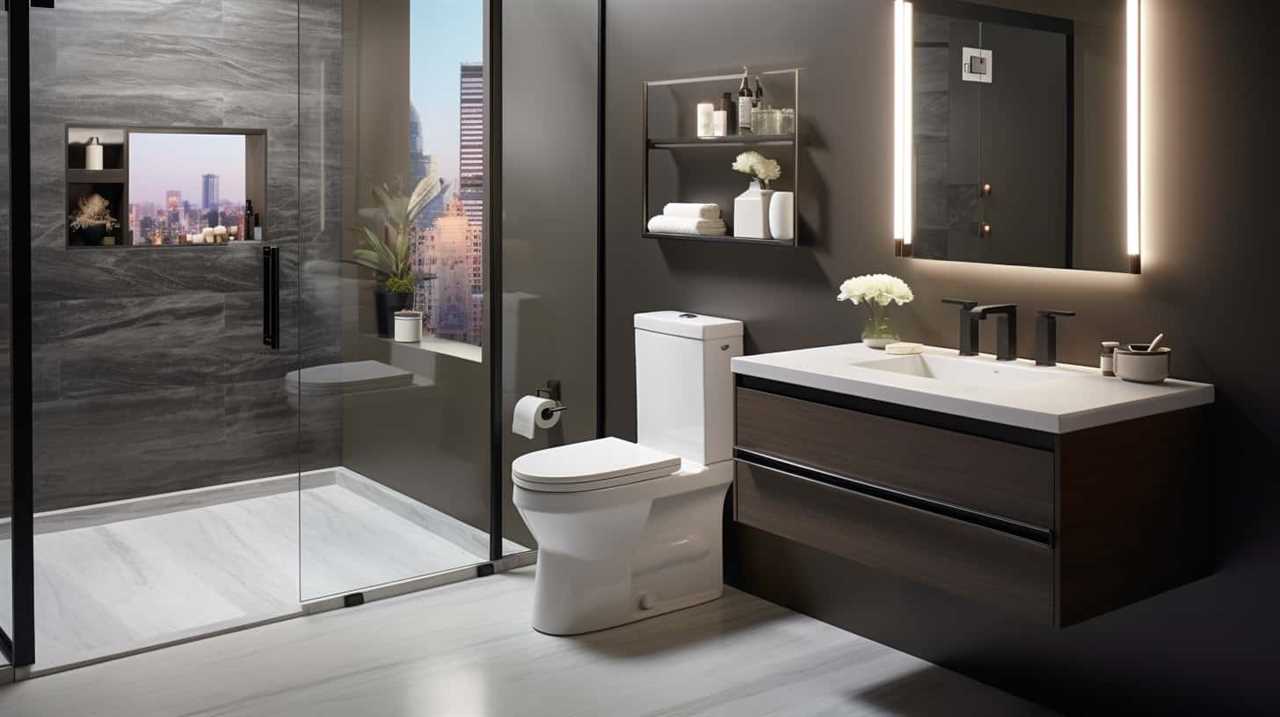
Just like a well-oiled machine, it silently works in the background, ensuring a clean and fresh toilet experience for all.
